The USDA Forest Service Forest Products Laboratory's mission is to identify and conduct innovative wood and fiber utilization research that contributes to conservation and productivity of the forest resource and, in turn, sustaining forests, the economy, and quality of life. Reports on current research projects are periodically summarized in "Research in Progress" reports.
Read selected Research in Progress reports listed below. For additional Research in Progress Reports, see FPL's recently posted publications.
Overview
Forest Product Lab's participation directly affects the safety and reliability of wood and wood-based products in the U.S. marketplace. FPL's efforst help extend the use of one of our planet's best and most renewable resources—wood.
Bridges
Our research project intends to test integrated wireless sensors for daily monitoring of the wooden structure for moisture, fungal decay, and termite attack. On-site inspections would only be initiated when the monitoring sensors detect wood-moisture changes or termites directly and send that information by data acquisition back to a central computer system.
The main objectives of this project will be to (1) provide technical assistance with new timber bridge design and construction efforts, (2) salvage timber bridge components for further laboratory evaluation, and (3) draft a final project report detailing our findings. Achieving these objectives will provide new knowledge about the performance of timber as a bridge material in a high-desert climate of the United States.
The objective of this project is to evaluate the use of a remotely piloted aircraft as a supplemental inspection tool for timber bridges that present accessibility issues.
The objective of this research is to develop techniques and provide recommendations for improving the analysis of historic covered timber bridges.
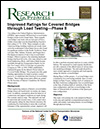
This study will continue the work initiated in Phase I to develop and establish recommended procedures for safely and reliably load-rating historic covered bridges through physical testing.

The objective of this project is to research the state-of-the-practice related to the use of concrete decks in conjunction with glued-laminated timber girders for highway bridge applications.

This study will assess, validate, and adapt a few advanced imaging tools and techniques for field condition assessment of wooden covered bridge members.

As part of the Bridge of the Future Initiative, the Federal Highway Administration (FHWA) developed the Geosynthetic Reinforced Soil (GRS) Integrated Bridge System (IBS). This project aims to design, construct, and monitor in-service performance of glulam girder bridge superstructure and wood timber facing elements in conjunction with a GRS–IBS.
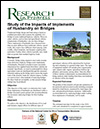
The objective of this study is to determine how loads from implements of husbandry are distributed within a bridge structural system and provide recommendations for accurately analyzing bridges for their loading effects.
Building Systems
Changes in residential energy codes are driving builders and residential designers to seek new wall assemblies in their designs. The project objective is to educate residential homebuilders, designers, and building code officials on how to cost-effectively and efficiently construct an energy-efficient house with 2×6 advanced framed walls.
The objective of this project is to develop a Builder's Guide to support and accelerate wider adoption of energy-efficient wall systems in residential construction by providing builders with practical solutions to construction of high-performance walls that (1) can be readily implemented in the field using available methods and materials and (2) can withstand the test of time from environmental and structural loads.

The objective of this research is to identify robust design rules and construction practices for durable exterior wood-frame and wood-sheathed walls in a mixed-humid climate.
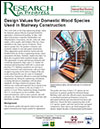
The overall objective of this research is to develop strength and stiffness design values for the most widely used domestic species in the grades and sizes that are used in stair, guard, and other structural applications. It also seeks to include graduate student education and professional training as a major developmental objective.
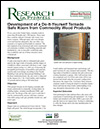
This project focuses on developing a tornado safe room constructed of commodity wood products including lumber, OSB, and plywood.
The objective of this research is to develop a reliability-based approach for quanitifying the likelihood of true mold growth in wood buildings given environmental conditions.
The objective of this project is to develop instructional videos that can be used for professional development and continuing education within the housing industry.
The objective of this research project is to conduct a field assessment of the EP&B wall framing system. One demonstration site will be located in a cold climate zone (such as CZ4, 5, or 6).
The objective is to develop data and models needed for fire safety engineering of forest products in a performance-based building code environment.
The objective of this project is to evaluate the hygrothermal performance of energy-efficient light-frame walls constructed with WSPs and different types of exterior continuous insulation through monitoring of wall performance in the cold climate zone in Madison, Wisconsin, through controlled environmental exposure in the chamber for analytic research on wall assemblies exposed to simulated weather (CARWASh) testing facility at the FPL and through computer modeling.
The objective of this research project is to develop test data needed to characterize the lateral load performance of SIP walls with full bearing. Phase 1 of the project involves structural testing of 24 full-size SIP walls of various configurations that will bracket a range of SIP wall configurations commonly used in the field.
The objective of this research is to identify robust design rules and construction practices that will mitigate excessive moisture accumulation in exterior walls that are sheathed with wood-based material and clad with absorptive siding material in a mixed humid climate.
Residential construction is a major part of the U.S. economy, driving job creation, economic growth, and individual prosperity. This study focuses on obtaining feedback from key stakeholders on the challenges, innovation barriers, and research needs facing the residential industry.
The objective of this project is to develop reliable estimates of types and amounts of wood products used to maintain and improve residential structures in the United States in 2014, to evaluate changes since 2006 (the year of the most recent wood residential repair and remodeling study) in both types and quantities of wood products used and ways in which wood products were used, and to determine economic drivers that influence repair and remodeling activity in the United States.
The objective of this project is to evaluate the possibility of combining WSP sheathing and foam insulation in wood-frame wall applications to satisfy both structural and energy conservation code requirements.
Cross-Laminated Timber (CLT)
The objectives of this project are to develop a design methodology and to demonstrate performance for exterior bearing CLT walls used in buildings subject to force protection requirements. This methodology should be published by U.S. Army Corp of Engineers – Protective Design Center to be used by engineers for designing CLT elements to withstand blast loads as determined by code requirements and specific project conditions.
The objective of this project is to provide key baseline technical data on adhesion properties for using hardwoods in CLT products. Properties of wood-adhesive bonding are affected by many factors, such as wood species, moisture content (MC) of wood at gluing, wood surface preparation, wood grain orientation, adhesive, and bonding parameters. The focus of this project will be wood species. Our specific objectives are to investigate (1) bonding strength, (2) bonding durability, and (3) dimensional stability of mixed-species CLT panels.
The objective of this research is to perform several large-scale compartment fire tests on a two-story CLT building to better understand the contribution of CLT to the compartment fire, life safety of occupants, firefighter safety, and property protection.
Prior research showed that inward moisture diffusion from absorptive claddings such as brick veneer, stucco, or manufactured stone veneer can be significant in wood-frame walls. The inward migration of moisture is greatest when the cladding is heated by the sun after being wetted by rain. The same phenomenon is likely to occur in CLT walls with these types of claddings.
The objectives of the project are to measure moisture conditions in CLT walls with absorptive claddings under exposure to simulated rain and sun and to identify design and construction practices that minimize the risk of moisture accumulation in different U.S. climates.
The objectives of this project are to (1) determine the resistance of this construction material to two commonly occurring subterranean termites, Reticulitermes spp. and Coptotermes formosanus, (2) develop a termite laboratory assay that accommodates the large size of CLT material, (3) compare three methods for assessing termite resistance, and (4) compare resistance of indoor and outdoor use CLT with comparably sized dimensional and laminar wood products.
The objectives of this research are twofold: (1) to document the CLT installation process with photography and video and (2) to install sensors in the CLT panels and collect data on in-service moisture and temperature conditions.
The growth of the cross-laminated timber (CLT) panel market has made available manufactured wood panels that are ideal for tornado safe rooms and shelters. The thick cross-section of the laminated panels are well suited to resist wind and impact loads produced by tornadoes.
The objective of this project is to develop a RTA tornado safe room and shelter from CLT for use in existing and new residential and commercial construction.
The objectives of this research are (1) to develop seismic performance factors for CLT subject to a peer review panel process that includes an independent peer review committee report and (2) to have the resulting seismic performance factors recognized in ASCE 7 Minimum Design Loads for Buildings and Other Structures.
The purpose of this Forest Products Laboratory partnership with Colorado State University is to determine seismic performance factors for CLT, thereby enabling CLT to be used efficiently and competitively throughout the United States.
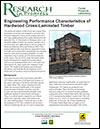
The goal of this project is to examine whether CLT panels made from low-grade hardwood lumber can provide sufficient engineering performance needed for structural applications. Our specific objectives are to evaluate the baseline structural properties (mechanical strength and stiffness) of CLT panels manufactured from low-grade northern hardwoods and develop mathematic models for predicating hardwood CLT engineering properties and optimizing the layup of CLT panels for maximum performance.
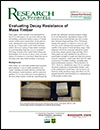
Mass timber, which includes cross-laminated timber (CLT), has begun to see use in the mid-rise and tall building construction market in parts of Canada and the northwestern United States. In the past few years, manufacturers have looked toward expanding the use of mass timber in the North American market. However, testing of mass timber resistance to wood-degrading fungi has yet to be examined. With large sections of the United States falling into Intermediate (3) to Severe (5) decay zones, an examination of resistance to wood decay fungi that may infest large-scale mass timber products is necessary.
The objectives of this project are to determine the resistance of CLT to commonly occurring wood decay fungi; develop a soil block assay that accommodates the large size of CLT material; and compare methods (visual ratings, mass loss, and x-ray density profiling) for assessing fungal decay in CLT.
The objective of this research is to identify building envelope design and construction practices for robust hygrothermal performance of ICLT walls in multiple U.S. climates.
The two major goals of this research project are to (1) obtain a benchmark dataset for moisture levels in different components of CLT building envelope under different climate conditions and (2) develop and calibrate hygrothermal simulation models for CLT material in real building applications.
The objective of this research is to quantify differences in structural failure risk of CLT panels manufactured with different adhesives.
The objectives of this research are to investigate changes in surface properties of borate-treated wood, specifically how it might affect adhesion of different formulations to treated wood; and to determine the efficacy of borate treatment in improving decay, termite, and fire performance of CLT.
The objective of this feasibility study is to assess the cost and structural performance of a single-family house constructed with mechanically fastened CLT panels. Low-grade lumber produced from beetle-killed pine will be incorporated in the panels to determine the potential for maximizing utilization of this material.
The overall objective of this project is to demonstrate new technologies to test the wood quality of dead and dying standing trees resulting from spruce-budworm activity for the production of a value-added engineered wood product: cross-laminated timber (CLT) panels.
The objective of this research is to promote the application of mass timber products, especially CLT, by identifying a range of suitable coatings that can prolong performance and the natural appearance of these products used in the construction of tall buildings.
To extend the work begun by the U.S. Tall Wood Building Prize Competition, this research will provide an integrated systems analysis that includes environmental, financial, and social criteria for three comparable buildings systems located in Portland, Oregon. This work provides a consistent set of data and an analytical framework that can be used to identify "hot spots" or high leverage points and the uncertainties that drive the benefits and costs of these systems.
The objective is to develop CLT as a viable retrofit option for soft story upgrades in earthquake-prone regions in the United States.
Life Cycle Assessment (LCA)
This work will expand capacity and accessibility of the Impact Estimator for Buildings software tool. This work will additionally strengthen market pull for LCA.
The objective of this project is to develop revised EPDs for six products following production of new LCA reports that provide the necessary environmental and energy use data, followed by third-party verification.
The University of Massachusetts (UMass) Amherst is building a wood structure to house classrooms, studios, computer labs, meeting rooms, a wood shop, and cafe. This “Design Building” (UM 2016) is a case study for demonstrating the carbon footprint and other environmental impacts reduction using sustainable wood materials. The internationally recognized environmental assessment tool called life-cycle assessment (LCA) offers a holistic analysis for the whole building from cradle-to-gate or cradle-to-grave assessment. LCA results can also be used to publish a summarized document called an environmental building declaration (EBD) to display the carbon footprint and life-cycle impacts data, similar to a nutrition label on a food package.
The objective of the study is to produce materials for communicating the environmental performance of the Design Building at UMass Amherst. The intended use of the EBD will therefore be for educational and marketing purposes.

The objective of this project is to develop cradle-to-grave LCAs for U.S. wood pallets for both domestic and international consumption for the eventual creation of wood pallet environmental product declarations (EPDs) by the National Wooden Pallet and Container Association (NWPCA).
The main objective of this project is to provide up-to-date life-cycle data for production of wood products produced in all major U.S. regions, covering all processes from planting, growth, and harvest to manufacturing and packaging of products ready to leave the mill gate, on a five-year cycle. This project will focus on both major structural wood products and many nonstructural products.
Material Properties
The objective of this research is to investigate and quanitfy the effect that different kinds of knot groupings have on strength and stiffness properties of southern pine lumber. Over the long term, this study may also be used to improve lumber valuation practices and overall design performance.
The objective of this project is to provide a thorough review of published literature pertaining to the influence of silviculture and growing environment on wood grade and mechanical properties in northern hardwood species of the Lake States, including sugar maple, red maple, basswood, yellow birch, American beech, black cherry, quaking aspen, white ash, and northern red oak.
The objective of this research is to develop new, sophisticated techniques to better understand the interactions between moisture, wood, and adhesives at the cell wall level to facilitate the development of improved adhesives for outdoor applications.
This study will determine types and amounts of VOCs that are emitted from common engineered wood products—useful data for users and producers of wood products.
Resource Management
The objective of this study is to develop advanced analysis techniques to enhance the performance and accuracy of automated structural lumber grading. This work seeks to use advanced signal analysis to locate major strength- and stiffness-reducing characteristics along the length of lumber specimens. In this manner, the trimming operation during lumber production can be more fully automated, thereby increasing efficiency and accuracy.
Loblolly pine (Pinus taeda) is among the most important tree species in the world in terms of wood utilization (McKeand et al. 2003). Recently, southern pine decline (SPD) has been identified as a potential factor in specifistands in the South where loblolly pine productivity is reduced or stands exhibit high levels of mortality. This phenomenon appears to be a combination of biotic and abiotic factors.
The objective of the study is to establish the relationship between pine trees suffering from SPD-like symptoms and wood quality.
Removing woody biomass from the Nation’s forests can reduce the risk of catastrophic wildfires and create healthy, resilient ecosystems. However, the costs of thinning can exceed the value of the thinned wood, making it uneconomical. Developing and expanding markets for wood in nonresidential and mid- to high-rise residential construction can help to make the removal of woody biomass more economical and lead to healthy, resilient forest ecosystems.
The objectives of this research are to (1) characterize charring rates under design fire scenarios so that these new charring rates can be developed into new, performance-based codes and (2) examine charring rates under several time–temperature profiles so an overarching model of char formation under any loading condition might be developed.
Much of our future timber supply is expected to come from improved softwood and hardwood trees grown on managed plantations or from small-diameter timber removed during forest management operations. Juvenile wood has substantially lower mechanical property values than mature wood. These reductions in properties may be mitigated through improved silvicultural practices, which require improved tools for monitoring stand quality.
Measuring MFA holds promise as one such tool. X-ray diffraction techniques have the potential to dramatically decrease the time required to determine microfibril angles (MFAs).
The objective of this project is to obtain additional empirical evidence for the theoretical relationship between a specimen’s microfibril angle, rotation, and tilt and the corresponding x-ray diffraction pattern. If the mathematics underlying the program accurately reflects the physics behind the x-ray diffractions, the program should be able to correctly estimate specimen rotations and tilts (known in the experiment). Also, MFA estimates for a particular specimen should be stable even in the presence of a variety of controlled rotations and tilts.
Subterranean termites are responsible for billions of dollars in damage to structures annually in North America (Bulmer et al. 2009), with the eastern subterranean termite Reticulitermes flavipes (Kollar) considered the most commonly encountered species. Although subterranean termites are most prevalent in the southern United States, certain species of Reticulitermes have been introduced and become established in regions further north in the United States and Canada. Various researchers have attempted to examine thermal tolerance in these introduced populations, but much remains unknown regarding their physiological adaptations to cold.
The objective of this research is to characterize fungi that are found in the soil and colonizing wooden field stakes within different decay hazard zones of North America as described in the AWPA Hazard Zone map.
Working with a variety of industry associations, waste management companies, and government agencies, this research and technology transfer effort will develop strategies to help reduce the amount of wood
The objective of this study is to examine the potential for using chitosan as a wood preservative against termites.
The objective of this research is to better characterize the flammability of foliage for invasive and noninvasive species. The study will improve testing conditions in the cone calorimeter and take advantage of improved instrument features, such as the FTIR gas analysis and high-precision weigh scale.
Decay hazard has been used extensively for approximating likelihood of biodegradation of wood-based products, but there is currently little biological component to these calculations. They are simply measures of the physical environment (mean temperature and rainfall) and do not account for the contributions or biodiversity of micro-organisms in each decay hazard zone. Our data would strengthen and expand the existing decay hazard map with detailed biological information.
The objective of this research is to characterize fungi that are found in the soil and colonizing wooden field stakes within different decay hazard zones of North America as described in the AWPA Hazard Zone map.
Ultimately this initiative aims at catalyzing a community paradigm shift in the urban wood removal and utilization stream. The application can be used for cost-benefit analysis of the entire wood removal stream in an easily accessible format, and the dataset will become more valuable as applications become increasingly utilized in urban forestry, urban ecology, urban planning, and city engineering.
Extreme weather conditions often cause uprooting of trees in forests, yards, urban areas, and along roadways. When this happens, landowners feel the need to act fast to clear fallen trees. This hasty reaction does not lend itself to a coordinated effort to identify value-producting and cost-effective clean-up practices.
The USDA Forest Service Forest Products Laboratory, in cooperation with organizations from around the world, develops nondestructive evaluation technologies as part of its program to find the best uses for our timber resources. To make the best use of our forest resources, we need to have technologies that help us assess the quality of a particular tree, log, or primary product. We can then identify its best use—nondestructive evaluation technologies enable us to characterize important properties of wood, allowing us to use it appropriately.
Historically, fuel management has been a commonly used technique for fire protection. This study investigates the potential use of round ponderosa pine posts from fuel reductions thinning within existing standard guardrail systems.
The past decade's beetle epidemic is unprecedented in its environmental and social impacts. The underutilized affected timber can be used in housing and commercial construction. This project investigates optimizing no-glue solid timber panel assemblies using beetle-killed pine.
The primary objective of this study is to investigate and statistically analyze the stiffness and strength distributions of mill run Southern Pine lumber in an effort to generate an improved means of assessing left tail percentiles. The secondary objective is to investigate the use of a wide range of nondestructive evaluation technologies, including slope of grain detection via permittivity, as a means of improving the predictability of stiffness and strength of structural pine lumber as well as improving the automation of these properties.
Treated Lumber
The objectives of this project are to (1) determine if changes in processing conditions can significantly reduce within-charge retention variability and (2) evaluate how changing treatment parameters affects weight gain and processing time.
The objective of this research is to develop ASTM standards for the evaluation of FRT glulam and LVL in support of wood-frame construction, especially Type III construction. This study is intended to cover the evaluation of FRT glulam and LVL in various sizes and will not be limited to the relatively small dimension glulam and LVL rim boards, even though it will be one of the targeted areas. ASTM D5516 and D6305 for plywood and ASTM D5664 and D6841 for lumber will be used as guides. It is also expected that the existing FRT chemicals for lumber and plywood could be used for glulam and LVL with limited modifications. Collaboration with the FRT industry is expected. The glulam volume effect and the SCL depth effect will be considered in this study.
This project focused on developing reuse options for treated decking lumber destined for the landfill.
Lumber used in outdoor construction must be pressure-treated with preservatives to prevent damage from decay and insects. The amount of preservative needed to protect the wood (called preservative retention) is initially determined by decay and termite testing prior to commercialization. Once in commercial use, the retention of every charge of treated lumber is checked at the treating plant to make sure it contains the intended amount of preservative. These retention checks are a key step in ensuring that treated wood products are durable.
The objectives of this project are to (1) refine devices for modifying instruments for use with fewer cores, (2) determine the minimum number of cores needed to conduct the analysis and develop accuracy and precision data for this approach, and (3) develop a draft standard for treaters to use when following the multiple retention assay method.
Although wood has several advantages over other construction materials—including being sustainable, aesthetically pleasing, and easy to work with—about 10% of timber cut in the United States is used for replacement of wood that has decayed due to its biodegradability. The goal of wood protection is to extend the life span of wood exposed to the environment, so aiding the process of carbon sequestration. However, over time, microorganisms can overcome preservatives and decrease their efficacy. Identifying microorganisms, discovering the sequence of events that promote their colonization, and understanding specifics of their species interactions and mode of attack are crucial for development of targeted, more efficient wood preservatives.
The objective of this research is to identify the bacterial species that colonize preservative-treated wood in contact with soil. This study will improve our current understanding of the role of bacteria in the biodeterioration of preservative-treated wood.
Pressure-treated lumber is widely used for a range of outdoor construction applications, including those that are structurally critical. The durability of treated lumber is dependent on the retention (or concentration) of preservative within the wood. Preservative retention is determined for every charge of lumber, but the measured retention value may differ if the same charge is analyzed a second or third time. Although such variation is known to exist, the extent of the variability has not been well quantified.
The objectives of this project are to (1) characterize the variability expected in retention values when treated-wood charges are measured multiple times and (2) determine operational target levels given the observed variability.
The objective of this research is to explore the feasibility of using strobilurins as a co-biocide.